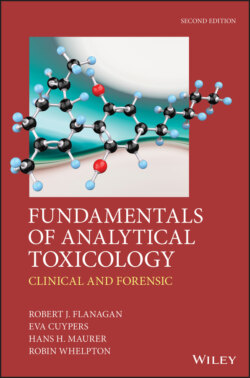Читать книгу Fundamentals of Analytical Toxicology - Robin Whelpton - Страница 19
Box 1.1 Opiates, opioids, and opium
ОглавлениеOpium is the dried residue obtained from the white, viscous fluid that exudes from the unripe seed head of the opium poppy (Papaver somniferum) when it has been cut
The opium poppy is the major source of the drug morphine, but also contains the closely related alkaloids codeine and thebaine. Opium also contains meconin, noscapine, papaverine, and reticuline, amongst other compounds, which are not structurally related to morphine and are not analgesic
Purified morphine and thebaine are used as starting materials for semi-synthetic drugs such as dihydrocodeine and oxycodone
Acetylating morphine produces diamorphine, which was introduced in Germany in 1895 as an antitussive under the name Heroin. The addictive properties of diamorphine quickly became apparent and the importation, production, and use of diamorphine was banned in the US in 1924, for example
The term ‘heroin’ is now generally used to refer to the impure diamorphine obtained by treating semi-purified opium with an acetylating agent, usually acetic anhydride. Acetylcodeine is a common contaminant of heroin
Strictly, the term ‘opiates’ refers to substances obtained from opium, not all of which have morphine-like properties, whereas ‘opioids’ are materials with morphine-like properties
The term ‘opioid’ can thus apply to not only naturally occurring and semi-synthetic compounds such as morphine and oxycodone, but also synthetic drugs such as methadone and dextropropoxyphene, as well as naturally occurring transmitters, for example met-enkephalin and leu-enkephalin
The term ‘narcotic’ originally referred to any psychoactive compound with sleep-inducing properties. In the US it has since become associated with opiates and opioids, commonly morphine and heroin, as well as stimulants such as cocaine, but is clearly non-specific and is best avoided
An important consideration is that the MS detector is a reaction detector, i.e. the signal obtained is dependent on chemical reaction(s) occurring in the ionization source. Therefore, the signal obtained is dependent not only on the analyte, but also on the possible presence of co-eluting compounds that may affect the ionization of the analyte. This is not normally a problem in GC-MS because the carrier-gas (usually helium) has little influence and the selectivity of the system is such that the analyte is usually fairly pure when it arrives at the ionization source. Not so with LC-MS, where either the suppression, or enhancement of the analyte signal due to the presence of co-eluting compounds can be significant.
